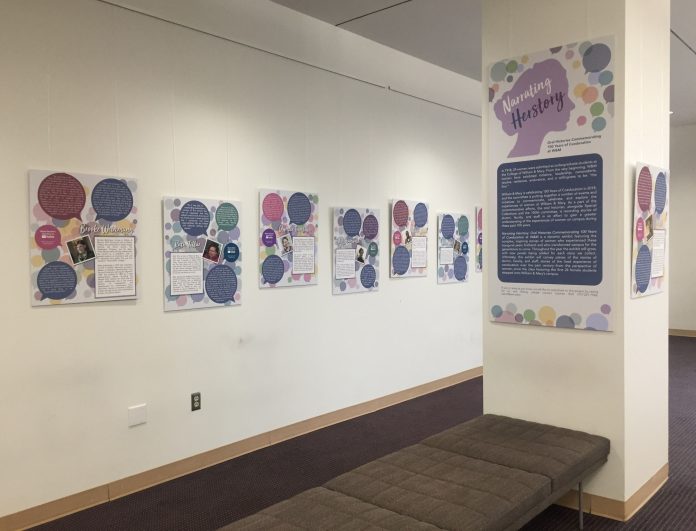In the Earl Gregg Swem Library Entrance Gallery, the stories and faces of 11 women who studied or worked at the College of William and Mary over the years are made visible on the walls. They are on display as part of a special exhibition entitled “Narrating Herstory: Oral Histories Commemorating 100 Years of Coeducation at W&M” organized by Special Collections and the 100th Committee. The exhibit began Sept. 22, 2018 and will remain on display until May 12, 2019.
This exhibit is a small representation of a much larger project. Approximately 40 oral histories have been recorded so far in commemoration of a century of women at the College—32 of which are currently available to view in full on the William and Mary Libraries YouTube channel.
Jennie Davy, the Exhibition Manager at Special Collections, explained the purpose of displaying these stories in the library.
“We wanted a way to share their stories, experiences, and reflections with the campus community,” Davy said in an email. “Many of the interviews are available on YouTube, but at 1 hour-plus each, we wanted an additional way to share their stories. We started last academic year with Living the Legacy, a poster exhibit of interviews conducted for the 50th anniversary and continued this year with Narrating Herstory for the 100th.”
Each panel in the exhibition features a photo, short biography, some selected quotations from the interview and the URL of the full oral history. The biographies and quotations were compiled by Mosaic intern Zaira Mughal.
One panel from the exhibit pictures Ruth Tillar ’45. Tillar recalls her time as a member of War Activity Members on campus and “going to the Methodist Church, then Methodist Church tower to spot aircraft” during World War II. She majored in home economics.
In the exhibit, Carolyn Hines ’72 E.d.D ’78 shared her experience in the exhibit as an African American woman on campus in the 70s.
“The dean of the school offered to pay my tuition to attend Virginia State University,” Hines said.
Hines responded: “No, I’ll stay here at William and Mary.”
Glenne Harding ’65 recalls the strict rules female students faced on campus.
“First semester freshmen women had to be in their dorms Monday through Thursday at 10:00 and on the weekends at 11:00,” Harding said in the exhibit. “During the week [we] couldn’t speak to boys after 7:00.”
Harding remembers learning about President John F. Kennedy’s assasination while in class in 1963.
“You hear people say I’ll never forget where I was,” Harding said. “And of course you won’t ever forget. I was in a math exam, calculus exam…”
The College’s oral history project was started in 2017. Oral Historian Carmen Bolt, who curated the exhibit, explained the mission of the project.
“[The purpose of this program is to collect and archive] the trials, the triumphs, the traditions, and the transformations of members of the William & Mary community, and contribute to a more complete understanding of the lived experience on campus,” Bolt said in an email.
Bolt emphasized the value of this project and exhibition in terms of its ability to tell untold stories.
“By recording, archiving and making these stories available, we are expanding what has traditionally been a predominantly white, male, heteronormative recorded history to include individuals who were active participants all along but fell, or were actively pushed, outside of the dominant narrative being told,” Bolt said.
Abram Clear ’21, Student Graphic Design Assistant in Special Collections, designed the panels and agreed that the nature of oral history is inherently subversive.
“The oral histories showcased in this exhibit accentuate oftentimes marginalized narratives while celebrating the power and remarkability of their narrators,” Clear said.
Clear took care to maintain that sense of power when designing the exhibit panels.
“To provide the most authentic depictions, we used only direct quotes,” Clear said. “Participants voiced their own experiences on their own terms.”
The panels will be switched out regularly for the remainder of the exhibition, in order to highlight a wider variety of perspectives and stories preserved by the project. As for the project as a whole, Bolt hopes that this is just the beginning.
“I envision this project becoming part of something larger and more all-encompassing — an oral history project dedicated to chronicling the lived experiences of women and woman-identifying individuals at W&M, past, present and future,” Bolt said.
Bolt feels that oral history has a lot to offer in terms of bringing untold stories into the light.
“Not only is oral storytelling utterly unique in its ability to convey meaning-making, it reintroduces the ‘human’ into our telling of history and inserts specific groups and individuals, particularly those that fall outside of the dominant narrative, into the larger context of which they have always been a part but have not always been recorded,” Bolt said.
“Narrating Herstory” will remain on display in the Entrance Gallery until May 12, 2019.
Correction: A former version of this article incorrectly stated that the “Narrating Herstory” exhibit ended on May 18, 2019 when the exhibit will actually end on May 12, 2019. The article has been corrected to provide the correct end date for the exhibit.

